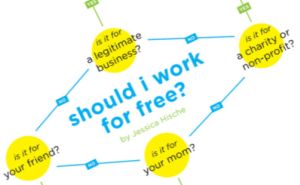Work On Spec
My recent post on free pitch issues got me thinking. This relates to free work. On spec. Having to spend time and money doing something for a prospect with no guarantee you’ll ever see cash for your endeavours.
I can’t think of anyone that likes this. So how come so many people do it?
I decided to look deeper at a campaign aimed at reversing this incredibly damaging and shockingly one-sided affair in the world of design. #nospec.
The anti-speculative work movement rally around such as this slideshare presentation, from Owen Shifflett;
 And there’s this useful debunking of 28 supposed benefits of doing spec work from a designer’s perspective.
And there’s this useful debunking of 28 supposed benefits of doing spec work from a designer’s perspective.
Work up-front for free is something a true solution seller should never do. I’m not talking about the freemium kind of trial product experience, as advocated so well by Jason Fried in his recent Rework. I’m a big fan of small toes in the water when the potential buyer then spends significant time with your product.
I refer rather to the nospec scourge of Jam Tomorrow. If prospects want something, they should pay a fair rate for it. Proper partnership means if it has a value, then you both commit equitably towards its provision.
The kind of re-education the nospec movement document is also valid when that pesky prospect wants a few days of free on-site services, or for you to show them your IP in detail, or to let them use your products without any of the customary accompaniments that let them outshine the rest.
For me, you simply must visibly experience clientside commitment commensurate with your efforts. Something for nothing is just not an option. No matter how hard it might be, turn down work where any imbalance emerges. It will always leave you better off.
It may sound like an impossible conversation to have with a buyer claiming their wallet is ajar. Yet it will likely not only set you apart from the rest, but place your bid on another plane altogether by standing your ground.
Even if you have the luxury of pre-sales resource, any kind of validation to prove your concept is not the same as this strand of debilitating freebie. If they’re not prepared to meet you on this, your time is always better spent elsewhere.
footnote: I came across this delightful guide a few months after posting this from a graphic designer’s point of view but readily applicable elsewhere:

